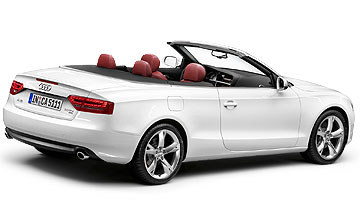BY MARTON PETTENDY | 14th Aug 2009

Beautifully proportioned and sleek with its soft-top up or down, the open-top version of the B4-series Audi 80 Coupe was the epitome of luxury motoring, and marked the beginning of an Audi tradition that lives on in the new A5 Cabriolet.
Never mind that the even sexier Audi TT Cabriolet effectively replaced the original Audi Cabriolet until the first A4 Cabriolet succeeded it almost a decade later in 2002, or the fact that Audi finally has a bona fide two-door version of the A4 in the new A5 Coupe.
Because the A5 continues to be a stunning two-door in its own right and, unlike many of its topless premium mid-size rivals – like BMW’s 3 Series Convertible and the new Lexus IS250 – remains unencumbered by the necessity to fit a bulky folding hardtop into its boot.
As a result, the rag-top A5 maintains the same exquisite overall proportions as the A5 Coupe, and also delivers best-in-class boot space with the roof down, aided by a split-folding rear seat that’s simply not possible to engineer into a coupe-convertible.
Notching up another couple of wins over many of its hardtop competitors, the A5 roof can also be raised or lowered in record time at speeds of up to 50km/h, which can be handy as you approach the garage or when the heavens open unexpectedly.
Okay, so its hydraulic operation is not quite as quiet as the IS250’s sophisticated aluminium roof, but it sounds pretty darn inoffensive to us, and the Lexus delivers a swag-load more luggage space when its hardtop isn’t occupying the majority of it.
But the Japanese drop-top’s rear-end - like many lower-priced Europeans like the Volkswagen Eos, Renault Megane, Focus Focus, Holden Astra, Peugeot’s new 308 CC and, to a lesser extent, the 3 Series CC and Volvo’s C70 – achieves this by adopting the cab-forward, ‘big-bum’ look that’s so synonymous with the modern coupe-convertible.
Of course, the lower weight of a fabric roof also makes the A5 Cabriolet lighter than it might have been with a hardtop roof, but the open-top A5 is no lightweight and the reinforcement work that was part of its transformation from coupe to convertible has apparently negated much of that weight advantage.
Coupe-convertible proponents argue a folding hardtop also has advantages in terms of structural rigidity, quietness and security. But we doubt whether the theft rate of/from convertibles is any higher than it is for other vehicles and when was the last time you heard of a soft-top roof being knifed in the street?
Sure, the A5’s basic three-layer fabric roof isn’t as quiet as a metal equivalent, but a rather expensive ‘Acoustic’ roof option is claimed to reduce noise in the A5 Cabriolet cockpit to nearly coupe-like levels and wind buffeting in the cabin is as good as any convertible we’ve driven lately – except, surprisingly, the new 308 CC.
Just as unexpectedly, however, the A5 Cabriolet doesn’t feel quite as tight as some of its direct rivals when it comes to body stiffness. While there’s minimal sign of scuttle shake, which is the bane of convertible engineers and can be evidenced by quivering body components like A-pillars, the A5 Cab’s steering column does deflect more than that of the IS250, which we drove only a few weeks ago at its launch, over rough surfaces.
There’s not much in it, and the A5 Cabriolet is probably more rigid than the A4 it replaces, but Audi’s four-seater drop-top doesn’t feel as rigid as some of its German rivals and falls well short of the stiffest (two-seat) open-top cars, like Porsche’s Boxster and the Benz SLK.
That said, the newest A5 comes with all of the dynamic improvements of a platform it shares with the A5 Coupe and new A4 sedan, including a larger footprint and forward-mounted steering rack that combine to give the all-wheel drive chassis vastly better steering feel and response, and an overall ride/handling balance that no longer make sit a poor cousin to it chief German foes.
Yes, the new cabriolet is much more expensive than the A4 it succeeds a base level, but that’s largely because the bigger and more powerful 2.0 TFSI replaces the 1.8 Turbo variant, which didn’t come with a seven-speed dual-clutch auto or quattro all-wheel drive.
We drove only the six-cylinder variants at the launch and found the 3.2 FSI offered almost as much seamless acceleration as the lighter (and $18,000 cheaper) A5 3.2 FSI quattro Coupe.
With no less than 500Nm of torque on hand and only a whiff of turbo lag to endure, it’s even quicker than the flagship 3.2 FSI, despite being 75kg heavier and returning lower fuel consumption and emissions.
To top it off, the 3.0 TDI is also $4000 more affordable than the 3.2 FSI, making it the most sensible pick of the new A5 Cabriolet bunch – as well as a proposition for which the super-refined and value-packed new Lexus convertible has no answer.
No, the first diesel-powered Audi cabriolet doesn’t match the V6 petrol version’s crisper throttle response or higher redline.
But with far superior in-gear flexibility and overall driveability from its narrower but more useful powerband, 0-100km/h acceleration in a sports sedan-like 6.4 seconds and the environmental friendliness of a 6.8L/100km average fuel consumption rating, the diesel A5 continues the latest Audi Cabriolet’s tradition of being fit for a princess.